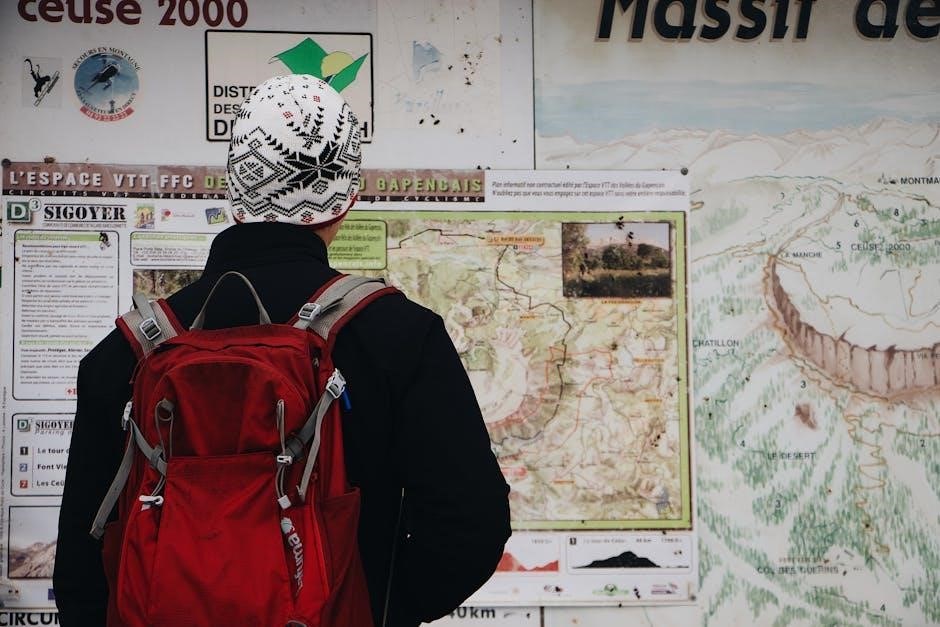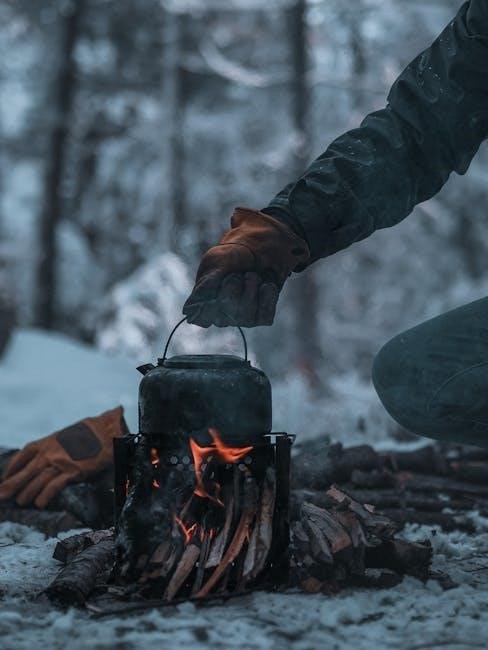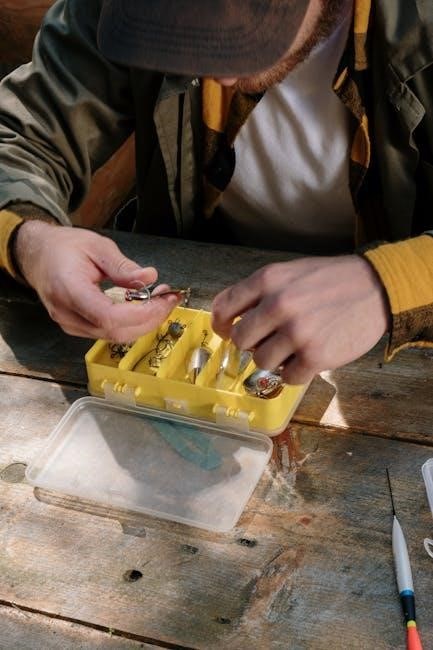Wilderness survival demands a deep understanding of nature.
Preparation through knowledge and a well-stocked survival kit is vital for navigating unforeseen challenges and ensuring your safety in the outdoors.
Importance of Preparation and Knowledge
Embarking into the wilderness without proper preparation is akin to navigating uncharted waters without a compass.
The importance of meticulous preparation and in-depth knowledge cannot be overstated when venturing into the outdoors.
A comprehensive understanding of survival skills, including fire starting, shelter construction,
and water sourcing, forms the bedrock of your safety net. Knowledge empowers you to identify edible plants,
administer basic first aid using natural remedies, and navigate using the stars or a map and compass.
A well-stocked survival kit containing essentials like a fire starter, knife, first-aid supplies, and navigation tools is indispensable.
Moreover, understanding potential natural dangers, such as extreme weather conditions, hazardous wildlife, and treacherous terrain,
allows you to make informed decisions and mitigate risks.
Preparation also involves thorough planning, including mapping your route, assessing potential hazards,
and informing someone of your itinerary. Prioritizing continuous learning and skill development,
coupled with proactive preparation, significantly enhances your ability to thrive in the wilderness.

Overview of Key Survival Elements
The core of wilderness survival revolves around a hierarchy of needs, with immediate priorities focusing on preserving life and ensuring well-being.
Shelter stands as a primary element, protecting you from the elements and conserving precious body heat.
Water is essential for hydration and bodily functions; securing a reliable source and purifying it is paramount.
Fire provides warmth, cooks food, purifies water, and boosts morale, making fire-starting skills invaluable.
Food, while less immediate than shelter, water, and fire, sustains energy levels and mental acuity.
Understanding how to identify edible plants and safely prepare them is crucial.
First aid knowledge, including treating wounds and addressing injuries using natural resources, is vital for managing health in the wilderness.
Signaling techniques are essential for attracting attention and facilitating rescue.
Navigation skills, utilizing a map, compass, or the stars, help you stay oriented and find your way back to safety.
Lastly, maintaining a positive mental attitude and cultivating resilience are key elements for overcoming challenges and enduring adversity in a wilderness setting.

Essential Outdoor Preparation
Outdoor preparation is key to staying safe in nature.
Essential survival skills, a comprehensive survival kit, and awareness of natural dangers are critical for a safe and successful expedition into the wilderness.
Creating a Survival Kit
Crafting a survival kit is a crucial step in outdoor preparation.
Include fire-starting tools like waterproof matches or a lighter.
A comprehensive kit addresses basic needs: shelter, water, fire, food, first aid, and signaling.
Consider a reference guide to surviving nature, focusing on outdoor preparation and remedies;
Knowledge is key, so include information on edible plants and natural dangers.
Tailor your kit to the environment. A well-prepared kit significantly boosts your chances of survival in the wilderness.
It should contain essential items and focus on the wilderness.
Ensure the kit includes ways to find natural resources and remedies for common injuries, it should also include a first aid kit.
A kit should align with survival skills, especially when treating wounds or creating shelter.
It’s a cornerstone for safe and prepared outdoor adventures.
Planning Your Expedition

Meticulous planning is paramount for any outdoor expedition, especially in the wilderness.
Begin by thoroughly researching your destination, understanding potential natural dangers, and identifying available resources.
A reference guide to surviving nature, focusing on outdoor preparation and remedies, can be invaluable.
Consider potential weather patterns, terrain challenges, and water sources.
Develop a detailed itinerary, including alternative routes and emergency protocols.
Inform someone of your plans and expected return date.
Ensure you have adequate maps, navigation tools, and communication devices.
Pack appropriate clothing, gear, and a well-stocked survival kit.
Learn basic survival skills, such as fire starting, shelter construction, and first aid.
Understanding edible plants and natural remedies is also beneficial.
Proper planning significantly increases your safety and enjoyment of the wilderness.
It ensures a safe and well-prepared adventure in the great outdoors.
Understanding Potential Natural Dangers
Venturing into the wilderness requires a keen awareness of potential natural dangers.
A reference guide to surviving nature emphasizes outdoor preparation and remedies, aiding in risk mitigation.
Weather conditions can change rapidly, posing threats such as hypothermia or heatstroke.
Be mindful of terrain hazards, including steep cliffs, unstable ground, and fast-flowing rivers.
Wildlife encounters can be dangerous; learn how to avoid attracting animals and what to do if approached.
Familiarize yourself with poisonous plants, insects, and other potential irritants.
Natural disasters, like wildfires or floods, can occur unexpectedly.
Assess the risk of falling trees or branches, especially during storms.
Understand the symptoms and treatment of common outdoor illnesses, such as Lyme disease or altitude sickness.
Carry a well-stocked first aid kit and know how to use it.
By understanding and preparing for these dangers, you can significantly reduce your risk in the wilderness.
Staying informed is crucial for a safe and enjoyable outdoor experience.

Prioritizing Survival Needs
In a wilderness survival situation, prioritize shelter, water, fire, and food.
Address immediate threats first, using your knowledge and resources from your survival kit to secure these essentials.
Shelter Construction Techniques
Mastering shelter construction is paramount for wilderness survival.
Prioritize creating a barrier against the elements using natural materials like branches, leaves, and snow.
The debris hut is a simple, effective option, offering insulation from cold and wind.
Lean-tos, constructed against a sturdy tree or rock face, provide quick overhead protection.
For colder climates, consider snow caves, offering excellent insulation when built correctly.
Focus on a compact space to conserve heat.
Familiarize yourself with various techniques, adapting to available resources and environmental conditions.
Practice constructing these shelters beforehand to build proficiency.
Remember, a well-built shelter is the shield that will protect your body and mind.
It is important to remember to use branches, moss, leaves and other natural elements to construct a shelter.
Also learn how to construct shelters like debris huts, lean-tos or snow caves.
Water Sourcing and Purification
Securing potable water is critical for survival. Identifying reliable sources is paramount; look for springs, streams, and even collect rainwater.
However, never consume untreated water due to potential contamination.
Purification is essential to eliminate harmful bacteria and pathogens.
Boiling water for at least one minute is a highly effective method.
Alternatively, consider using a portable water filter or purification tablets.
Constructing a simple solar still can extract moisture from the ground.
Be cautious of stagnant water sources, as they are more likely to harbor contaminants.
Conserve water by minimizing exertion and seeking shade.
Knowing how to find and treat water can save your life in the wilderness.
Remember, finding water is the holy grail of survival, but do not just drink any clean-looking water you see, even if it looks clean.
Fire Starting Methods and Safety
Mastering fire-starting is a cornerstone of wilderness survival, providing warmth, cooking capabilities, and a morale boost.
Several methods exist, each with its advantages.
The bow drill and hand drill require practice and skill, while lighters and waterproof matches offer convenience.

Always carry multiple fire-starting tools in your survival kit.
Gather tinder, kindling, and fuel wood before igniting a flame.
Construct a fire pit away from flammable materials, and never leave a fire unattended.
Be mindful of wind conditions, and keep water or sand nearby to extinguish the fire if necessary.
Learn to create a sustainable fire that conserves resources while providing essential benefits.
Understanding fire safety is crucial to preventing accidents and ensuring your well-being.
Remember, fire is a powerful tool, but it demands respect and responsible handling in the outdoors.

Finding and Preparing Food in the Wild
Identifying edible plants, safe harvesting, and proper preparation are vital skills for sustenance in the wilderness.
Nature offers a bounty, but knowledge is key to avoiding poisonous species and ensuring nutritional intake.
Identifying Edible Plants, Berries, and Fungi
Navigating the wilderness requires a keen eye and comprehensive knowledge of local flora.
Accurate identification of edible plants, berries, and fungi is paramount for securing a vital food source, but misidentification can be perilous.
A reliable reference guide, like “A Reference Guide to Surviving Nature,” becomes invaluable.
Understanding the unique characteristics of each plant – its leaves, stem, flowers, and fruit – is crucial.
Berries, while seemingly tempting, can be particularly deceptive; learning which ones to avoid is just as important as knowing which ones to consume.
Fungi identification demands even greater caution, as many species are toxic;
Cross-referencing multiple sources and employing the “universal edibility test” can minimize risks.
However, the best approach is to stick with plants you positively recognize, ensuring a safe and nourishing meal in the outdoors.
Safe Harvesting and Preparation Techniques
Once edible plants, berries, or fungi are identified, the next critical step involves employing safe harvesting and preparation techniques.
Avoid collecting plants near roadsides or areas with potential contamination.
Harvesting should be done sustainably, taking only what you need and leaving enough for the plant to regenerate and for wildlife.
Wash all foraged items thoroughly with clean water to remove dirt and potential parasites.
Cooking is often necessary to neutralize toxins or improve digestibility.
Boiling is a reliable method for many plants, while some require specific cooking times or techniques.
“A Reference Guide to Surviving Nature” can provide detailed instructions.
If unsure about a plant’s edibility, start with a small portion to test for adverse reactions.
Proper preparation not only enhances safety but also maximizes nutritional value, ensuring a sustainable food source in the wilderness.

Natural Remedies and First Aid
Wilderness first aid involves utilizing natural resources to address injuries when conventional supplies are unavailable. Knowledge of medicinal plants and their applications is essential for treating wounds and ailments effectively in outdoor situations.
Treating Cuts and Wounds with Natural Resources
When venturing into the wilderness, access to conventional first aid is often limited, making knowledge of natural remedies crucial.
For treating cuts and wounds, several natural resources can be utilized effectively.
Clean water, if available, is paramount for irrigating the wound to remove debris and reduce the risk of infection.
Certain plants, such as plantain, possess antiseptic and anti-inflammatory properties.
A poultice made from crushed plantain leaves can be applied to the wound to promote healing and prevent infection.
Yarrow is another valuable resource, known for its ability to staunch bleeding.
Applying crushed yarrow leaves to the cut can help to clot the blood and accelerate the healing process.
Honey, with its antibacterial properties, can also be used as a natural antiseptic.
Always ensure that the natural resources used are clean and free from contamination to avoid introducing further infection.
Addressing Sprains and Injuries Without a First Aid Kit
In the wilderness, dealing with sprains and injuries without a first aid kit requires ingenuity and knowledge of natural resources.
For sprains, the RICE method (Rest, Ice, Compression, Elevation) is still applicable.
Rest the injured limb to prevent further damage.
Cold compresses can be created using cold water or mud wrapped in cloth to reduce swelling.
Compression can be achieved by tightly wrapping the injured area with cloth or bark strips.
Elevate the injured limb to minimize swelling.
For pain relief, willow bark, containing salicin (a natural form of aspirin), can be chewed or made into a tea.
Splints can be fashioned from branches and secured with vines or cloth to immobilize fractures.
Seek professional medical attention as soon as possible.
Remember, these are temporary measures until proper medical care is available.
Using Medicinal Plants and Herbal Remedies
Medicinal plants and herbal remedies can be invaluable in a wilderness survival scenario.
However, proper identification is crucial to avoid poisoning.
Plantain, for example, can be used as a poultice for wounds due to its antibacterial and anti-inflammatory properties.
Yarrow can help stop bleeding and acts as an antiseptic.
Willow bark, as mentioned before, provides pain relief.
Usnea, a lichen, has antibiotic properties and can be applied to wounds.
Always test a small amount of any plant on your skin first to check for allergic reactions.
Prepare teas or poultices by boiling plants in water to extract their medicinal compounds.
Remember, while these natural remedies can provide relief, they are not substitutes for professional medical care.
Consult a field guide or expert before using any plant for medicinal purposes.
Responsible and informed use is key to benefiting from nature’s pharmacy.

Signaling and Navigation
Signaling is essential for rescue. Use mirrors, fires, and bright clothing to attract attention. Master map reading and compass skills for effective navigation to find your way home.

Basic Signaling Techniques
Effective signaling is crucial in a wilderness survival scenario, increasing your chances of being found. Employ a variety of methods to maximize visibility and audibility. Visual signals are paramount; utilize mirrors to reflect sunlight, creating flashes that can be seen from afar. Brightly colored clothing or materials laid out in distinct patterns can also catch the eye of search parties.
Building a signal fire is another effective technique. Ensure the fire produces a significant amount of smoke, which can be enhanced by adding green vegetation. Three fires in a triangle formation is a universally recognized distress signal.
Auditory signals, such as whistles or loud shouts, can also attract attention. A whistle’s sharp sound carries farther than the human voice. Remember the rule of three: three whistles or shouts repeated consistently signals distress. Understanding and practicing these basic signaling techniques can significantly improve your survival odds in the outdoors.
Staying Safe and Finding Your Way Home
Prioritizing safety is paramount when navigating the wilderness. Before venturing outdoors, meticulously plan your route and inform someone of your itinerary. Monitor weather conditions closely and be prepared for unexpected changes.
If lost, remain calm and avoid panic. Retrace your steps if possible, and utilize natural landmarks for navigation. If completely disoriented, stay put and signal for help. Conserve energy and ration supplies. Build a shelter and secure a water source.
Employ basic map and compass skills if available. Understand how to orient yourself using the sun and stars. Be aware of potential hazards such as wildlife, treacherous terrain, and extreme temperatures. By staying vigilant, resourceful, and level-headed, you can significantly increase your chances of staying safe and finding your way home. Remember, careful preparation is key to a successful and safe outdoor experience.
Mastering the art of wilderness survival is an ongoing journey that combines practical skills with a deep respect for nature. It requires continuous learning, hands-on experience, and a commitment to responsible outdoor preparation. A comprehensive reference guide, like “Surviving Nature: Outdoor Preparation and Remedies,” can be an invaluable tool, providing essential knowledge and techniques for navigating challenging situations.
However, knowledge alone is insufficient. It’s crucial to practice and refine your skills in a safe and controlled environment. Experiment with fire-starting methods, shelter construction, and water purification techniques. Familiarize yourself with local flora and fauna, learning to identify edible plants and potential hazards.
Ultimately, successful wilderness survival hinges on your ability to remain calm, adaptable, and resourceful. Embrace the challenges, learn from your mistakes, and never underestimate the power of preparation. With dedication and perseverance, you can develop the confidence and competence to thrive in the outdoors.
